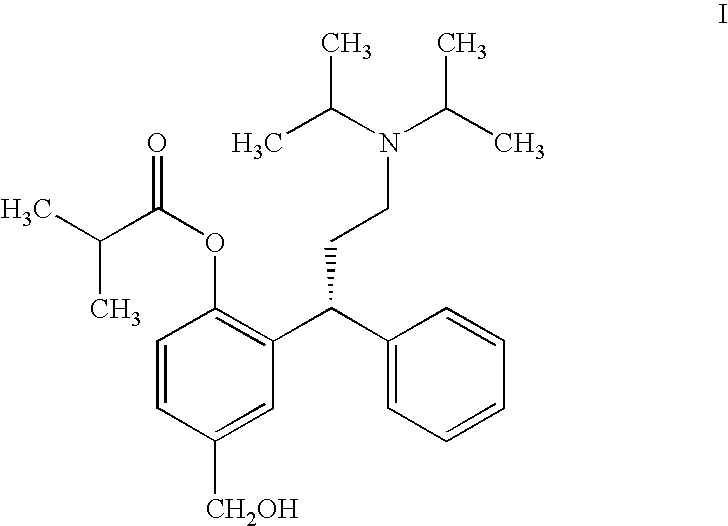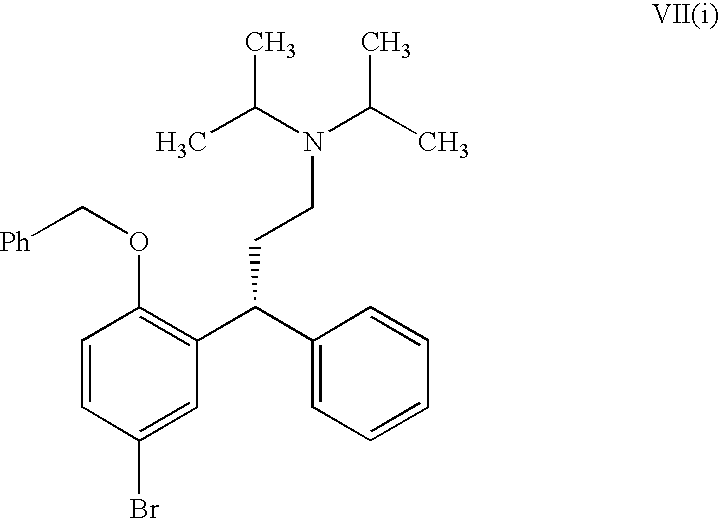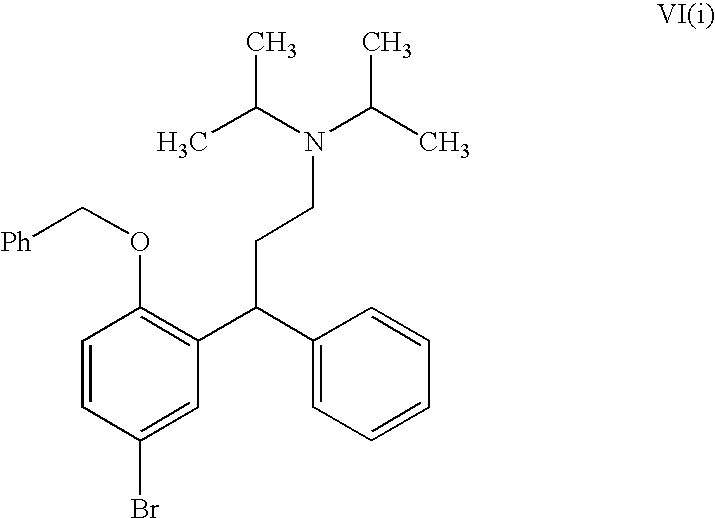Process for the Preparation of Fesoterodine
a technology of fesoterodine and process, which is applied in the preparation of sulfonic acid esters, organic chemistry, amino-carboxyl compound, etc., can solve the problems of low yield of product, process used, and inability to meet the requirements of chiral purity, and achieves less reaction time, convenient, commercially viable and environment friendly process, and easy handling at commercial scale
- Summary
- Abstract
- Description
- Claims
- Application Information
AI Technical Summary
Benefits of technology
Problems solved by technology
Method used
Image
Examples
example 1
Step-1: Preparation of 6-Bromo-4-phenylchroman-2-one
Method-A:
[0114]Cinnamic acid (100 g, 676 mmol), 4-bromophenol (123 g, 730 mmol) and sulfuric acid (13 ml) were taken into a 1 L 4-neck round bottom flask. The contents were slowly heated to 120-125° C. and stirred for 3 to 4 hours at 120-125° C. The reaction mixture was cooled to 80° C. followed by the addition of toluene (300 ml) and water (200 ml) and then stirred for 15 minutes. The toluene layer was separated and washed with water (2×100 ml). The resulting toluene layer was distilled completely under vacuum. Potassium carbonate solution (47% w / v-100 ml) was added to the residue at 25-30° C., the contents were stirred for 15 minutes, filtered the solid and washed with water (2×100 ml). The wet material was leached with 100 ml of isopropyl alcohol and then filtered. The resulting solid was washed with 50 ml of isopropyl alcohol and then dried the material at 70-75° C. to give 72 g of 6-bromo-4-phenylchroman-2-one (Melting poing: ...
example 2
Step-1: Resolution of (±)-N,N-Diisopropyl-3-(2-benzyloxy-5-bromophenyl)-3-phenylpropylamine
Method-A:
[0132](±)-N,N-Diisopropyl-3-(2-benzyloxy-5-bromophenyl)-3-phenylpropylamine (100 g) was dissolved in isopropyl alcohol (1500 ml). This was followed by the addition of (−)-di-p-toluoyl-L-tartaric acid (80 g). The reaction mixture was further heated at 80° C. and refluxed for 1 hour. The reaction mixture was then stirred for 12 hours at 25-30° C. The resulting solid was filtered, washed with isopropyl alcohol and then dried to produce 85 g of (R)—N,N-Diisopropyl-3-(2-benzyloxy-5-bromophenyl)-3-phenylpropylamine di-p-toluoyl-L-tartrate salt [Melting Range: 120-125° C.; Specific optical rotation: (−60°, C=1, Methanol)].
Purification Method-1:
[0133]The mixture of (R)—N,N-Diisopropyl-3-(2-benzyloxy-5-bromophenyl)-3-phenylpropylamine di-p-toluoyl-L-tartrate salt (85 g) and isopropyl alcohol (350 ml) was heated at 80° C. for 2 hours. The reaction mixture was cooled at 25-30° C. and stirred for...
PUM
| Property | Measurement | Unit |
|---|---|---|
| temperature | aaaaa | aaaaa |
| temperature | aaaaa | aaaaa |
| reflux temperature | aaaaa | aaaaa |
Abstract
Description
Claims
Application Information
 Login to View More
Login to View More - R&D
- Intellectual Property
- Life Sciences
- Materials
- Tech Scout
- Unparalleled Data Quality
- Higher Quality Content
- 60% Fewer Hallucinations
Browse by: Latest US Patents, China's latest patents, Technical Efficacy Thesaurus, Application Domain, Technology Topic, Popular Technical Reports.
© 2025 PatSnap. All rights reserved.Legal|Privacy policy|Modern Slavery Act Transparency Statement|Sitemap|About US| Contact US: help@patsnap.com



